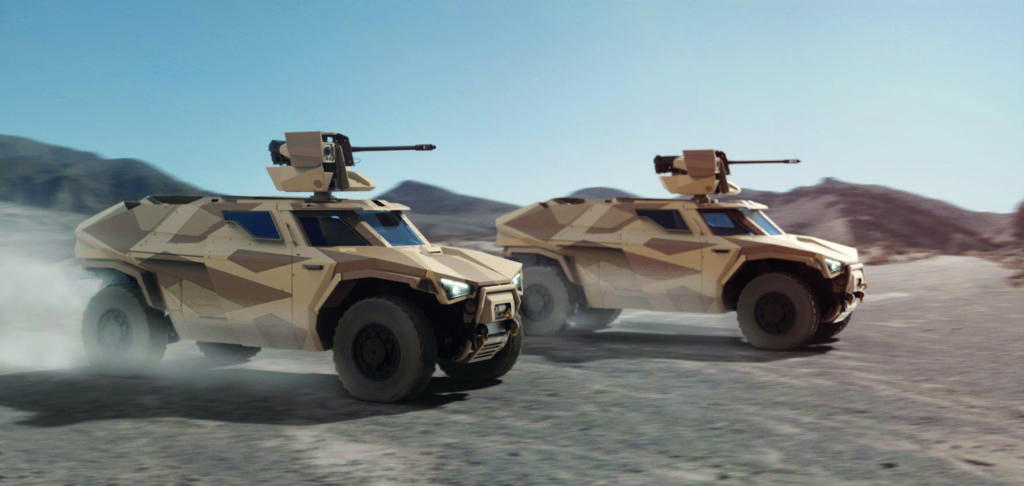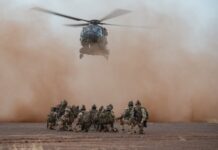The French Army is in the midst of an ambitious transformation effort, the SCORPION (Synergie du contact renforcé par la polyvalence et l’info valorisation) programme, that will totally redefine how it will conduct military operations and will require the acquisition of new combat systems to make it a reality. These new combat systems are starting to enter service with the French Army in limited numbers, in parallel with this many existing combat systems are being upgraded to extend their service lives and allow them to operate with the architecture of the SCORPION programme.
In this article, the objective is to focus on the acquisition of new armoured vehicles and the upgrade of existing armour assets to meet the requirements of the SCORPION programme. As far as the acquisition of new armour is concerned, French programmes will run from the present day right out to 2035 and the delivery of the first Main Ground Combat System (MGCS), the next generation Franco-German tank that will replace the LECLERC in French Army service.
Many saw the announcement of the first part of the System Architecture Definition Study (SADS Part 1) for the MGCS. The three partners in the programme, Krauss-Maffei Wegmann (KMW) and Rheinmetall in Germany and Nexter in France, will now work towards a ‘common multi-platform architecture’ for the MGCS that will be compatible with France’s SCORPION battlefield digitisation architecture and its German equivalent. For France interoperability between ground forces, air forces and other assets is an essential part of the SCORPION architecture, as is interoperability with allied forces.

If the MGCS represents the future of French heavy armour post-2035, up to that point it is the LECLERC that remains at the pinnacle of French armour. To remain in service through to 2035 it was necessary to upgrade the performance of the LECLERC with Nexter being awarded a contract to upgrade 200 tanks to the LECLERC XL configuration. This will have both military and industrial implications, first the military will benefit from increased combat capabilities for its tank and its integration into the SCORPION architecture, while Nexter will reinvigorate its tank industrial capabilities. What provides this integration is the Système d’information du combat Scorpion (SICS) Battle Management System (BMS) and the Thales COMBAT software-defined radio system. Other additions are an RWS mounting a 7.62×51 mm machine gun, plus a modular add-on armour package. The upgrade will also look to replace obsolescent components with more modern and supportable components.
As of 2019, the French Army had 241 LECLERC tanks in service, as previously noted the numbers of tanks to be upgraded number 200. The plan is to have upgraded 122 to the LECLERC XL configuration by 2025, with the rest of the fleet completing the upgrade over the following three or so years. It is important to state that programme timetables that were generated before the Covid-19 outbreak must now be considered as uncertain. As with other parts of Europe, France shut down its economy and government expenditure has risen alarmingly in the struggle against Covid, while tax income has declined. How long it takes the French economy to recover will be the crucial determinant of the amount of funding that could be available to fund defence programmes. There is also the 2022 presidential election to take into account, a change in government will inevitably impact on defence spending.
Replacement Options
The replacement of legacy armour is a key part of the overall SCORPION programme, one of the systems to be replaced is the AMX-10RC that was originally built by Nexter and entered service during the 1980s. Continuing the tradition of French wheeled armour, the 6×6 AMX-10RC was equipped with a 105 mm gun and had a 17 tonne combat weight. The vehicle was put through an upgrade programme, with Nexter being awarded a contract to upgrade 256 AMX-10RC vehicles to the AMX-10RCR configuration in 2000. The first upgraded vehicles were delivered to the French Army 2005 and the programme was completed in 2010. Currently the French Army has 250 AMX-10 in the inventory.
While the AMX-10 was a capable vehicle, it had one drawback in terms of weight, which limited its ability to deploy to French areas of interest in Africa for example. To meet this requirement the French Army opted to acquire a different wheeled armour system in the form of the ERC-90 SAGAIE produced by Panhard (a legacy company of ARQUUS). This is a 6×6 vehicle that is roughly half of the weight of the AMX-10RC and is equipped with a 90 mm gun. The ERC was developed by Panhard in the 1970s as the successor to the AML wheeled armour vehicle family and entered service with the French Army during the 1980s. There are currently some 80 ERC-90 vehicles in service with the French Army.

Both the AMX-10RC and the ERC-90 were credible armoured vehicles that could bring effective firepower to bear via their 105 mm or 90 mm gun armament. The successor vehicle to these two systems takes a different path in terms of armament choices, that vehicle is the Engin Blindé de Reconnaissance et de Combat (EBRC) JAGUAR. The JAGUAR armament package consists of a 40 mm CT cannon, two MBDA MMP anti-tank missiles and an ARQUUS HORNET RWS with a 7.62 mm machine gun. This is a 25 ton 6×6 vehicle and, as with all vehicles acquired under the auspices of the SCORPION programme, it will have the SCORPION vetronics system, the SICS BMS and the CONTACT radio system.
Apart from replacing the AMX-10RC and the ERC-90, the JAGUAR will also replace the version of the VAB vehicle equipped with the HOT missile system for the anti-tank mission. There are currently 300 JAGUAR on order and the plan is to have 150 delivered by 2025. The JAGUAR vehicle has also been acquired by the Belgian military with 60 vehicles on order as part of the CaMO wheeled armour modernisation programme.
The Nexter VBCI wheeled IFV will also come under the umbrella of the SCORPION programme. There are currently some 629 of these in service with the French Army. The intention is to put these vehicles through an upgrade programme as they have an important role to play in the French Army structure and have plenty of operational life remaining. There will also be the eventual introduction of a replacement to the Sagem FELIN (Fantassin à Equipements et Liaisons Intégrés) integrated soldier system. The first FELIN systems were delivered to a training establishment in May 2010, with the first operational unit taking delivery in September 2010. Another aspect of the SCORPION programme is its emphasis on the integration of advanced technology into ground forces operations, this will see the arrival of unmanned systems, both UGS and UAS, and there will be moves to utilise the potential of artificial intelligence to maximise the possibilities offered by the overall SCORPION programme architecture.
New Additions
Another new system being acquired under SCORPION is the Véhicule Blindé Multi-Rôles (VBMR) GRIFFON. This is a 6×6 vehicle and will eventually replace the VAB in French service; at present, there are 2,671 VAB with the French Army, with this number set to be reduced to 1,545 by 2025. The Direction Générale de l’Armement (DGA) procurement agency placed the first GRIFFON order for 319 vehicles in April 2017; the first vehicles were delivered to the French Army in 2019, and over 90 vehicles are now in service. The objective for 2025 is to have 936 GRIFFON in service.
In total 1,872 GRIFFON are to be acquired by France in multiple variants. More recently, in December 2019, the contract for the mortier embarqué pour l’appui au contact (MEPAC) system was awarded by the DGA, this consists of a Thales 120 mm 2R2M mortar mounted on a variant of the GRIFFON. In total 54 system have been ordered, the first will be delivered in 2023, with the remainder delivered between 2024 and 2027. The GRIFFON is also the largest element of the Belgian CaMO programme, with 382 vehicles on order and deliveries in progress.
The other major in-production armoured vehicle programme for the French Army is the Véhicules Blindés Multi-Rôles (VBMR) Léger SERVAL, being produced by Nexter and Texelis. In total 2,038 SERVAL vehicles are to be acquired in three different versions and 16 separate variants. The first order placed by the DGA covered the acquisition of 636 vehicles under a contract announced in February 2018. By 2025 the French Army expects to have 489 SERVAL in service.
Also to be acquired in the scope of the SCORPION programme is the replacement for the Engin Blindé du Génie (EBG) armoured engineer vehicle, the new system known as the MAC will be on a wheeled platform and is described as an engineer combat support vehicle. Mobility is to be similar to the other SCORPION wheeled armour systems, and some 100 systems are expected to be acquired.
The Panhard VBL is used by the French Army as a reconnaissance and liaison platform. Currently some 1,394 VBL are in service. ARQUUS is presently putting large numbers of VBL through the ULTIMA refurbishment and upgrade programme, with the objective being that the VBL fleet in 2025 will consist of 733 ULTIMA variants out of 1,387 in service. Under the SCORPION programme there is a requirement to replace the VBL with a successor vehicle known as the Véhicule Blindé d’Aide à l’Engagement (VBAE) that should enter service around 2025.

The VBAE could be a very interesting programme. In outline, the vehicle will be a 4×4 in the eight to ten ton range; multiple vehicle variants are envisaged and the aim is to have a higher level of protection than the current VBL. To complete its mission the VBAE will feature high mobility and a low signature to evade detection. Meeting the VBAE requirement could see new propulsion solutions offered, for example hybrid or perhaps even electric. Certainly reducing the noise signature of the vehicle would seem to offer the opportunity to employ an electric motor as the vehicle advances to contact.
Originally the SCORPION programme was seen as a battlefield digitisation effort, but it expanded into something far more complex than that. Perhaps it would be best to consider it as creating a structure and providing the tools for the French Army to confront both present day and future threats. In the context of armour the SCORPION programme has undoubtedly acted as the catalyst for a total refresh of the French armoured vehicle fleet.
David Saw




![A luxury or a necessity? Fire control systems for small arms Acquired as part of the Next Generation Squad Weapons (NGSW) programme, the new US Army M7 rifle and the 6.8 × 51 mm Common Cartridge, shown here paired with the Vortex Optics XM157 SA-FCS mounted on the weapon’s Picatinny rail. [US Army]](https://euro-sd.com/wp-content/uploads/2025/11/M7-Rifle-Kopie-218x150.jpg)
![Submachine guns: From their origins to the present day The ubiquitous 9 × 19 mm Luger round, today commonly referred to as 9 mm Parabellum, was the round of choice for the first SMGs, and continues to be widely used today. [USMC/Cpl Jonathan Beauchamp]](https://euro-sd.com/wp-content/uploads/2025/11/9mm-closeup_USMCCpl-Jonathan-Beauchamp-Kopie-218x150.jpg)
![Middle Eastern combat aircraft: Programmes and capabilities A Mirage F1BQ of the IRIAF, on 16 September 2009. Iran’s air forces have undergone a steady decline since the Revolution. [Shahram Sharifi, via Wikimedia Commons, CC-BY-SA-4.0]](https://euro-sd.com/wp-content/uploads/2025/11/Mirage-F1BQ-of-the-IRIAF-218x150.jpg)
![The US and China: Deep dependency amid increasing strategic competition Looking back at the heights of US strategic dominance in the 1990s, by 2025 the sun looks to have well and truly set on the unipolar international system. [US ANG/MSgt Luke Olson]](https://euro-sd.com/wp-content/uploads/2025/10/Sunset_US-ANGMSgt-Luke-Olson-Kopie-218x150.jpg)

![Market overview: Longevity and innovation in the machine gun sector The L7A2 General Purpose Machine Gun (GPMG) in action during a counter-ambush in Afghanistan by British troops. The L7A2 is the British version of the FN MAG, arguably the most successful Western GPMG. [Crown Copyright]](https://euro-sd.com/wp-content/uploads/2025/09/Afghan-GPMG-Kopie-218x150.jpg)
![Transport aircraft trends: A market overview The Xi’an Aircraft Industrial Corporation (XAC) Y-20 entered service with the Chinese military in 2016; the aircraft can be considered the Chinese equivalent of the Boeing C-17. A tanker variant is available, while the Y-20 also provides the basis for the new KJ-3000 AEW&C platform. [Cute Orca Weibo Account]](https://euro-sd.com/wp-content/uploads/2025/06/Y-20-China-Kopie-218x150.jpg)

